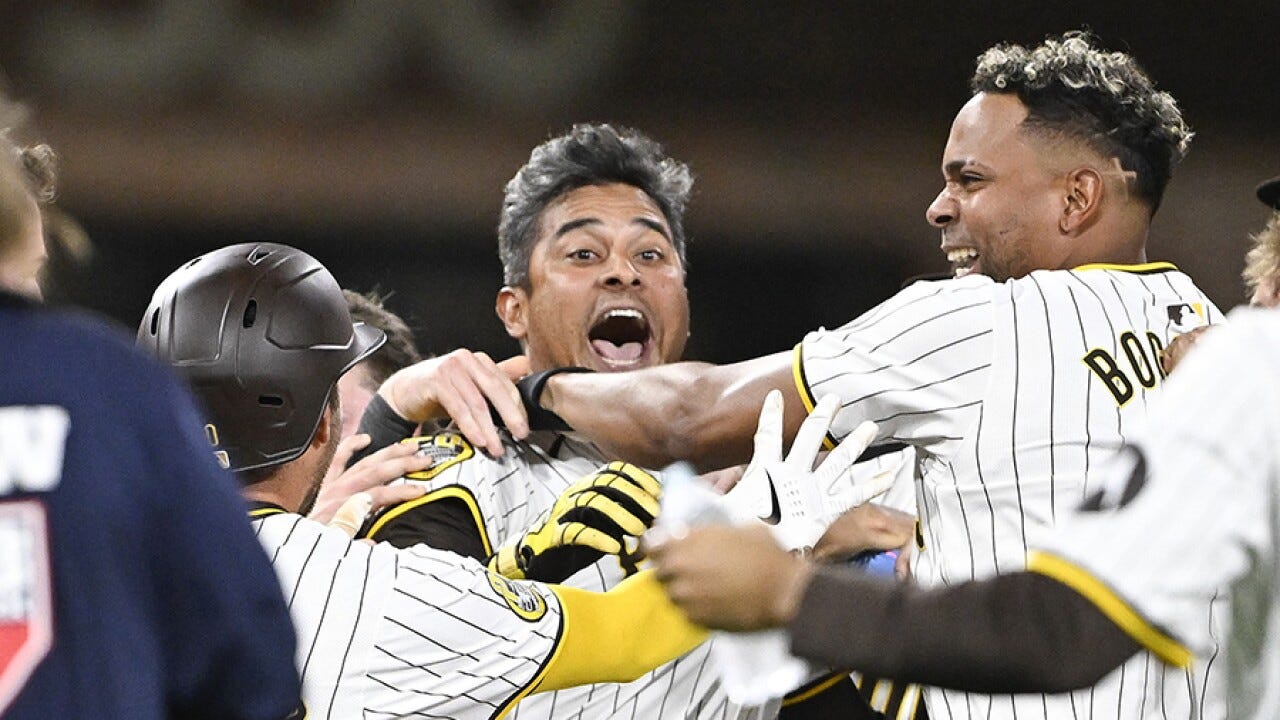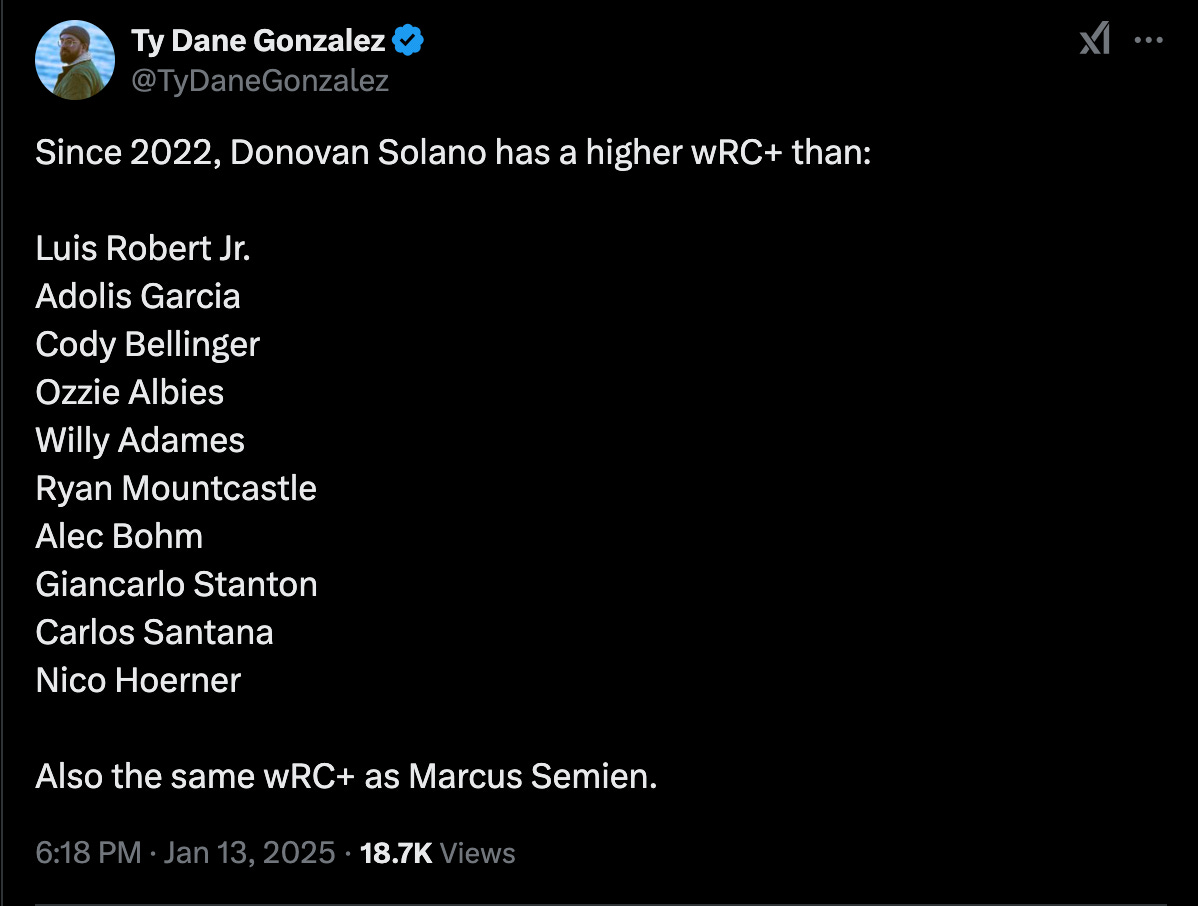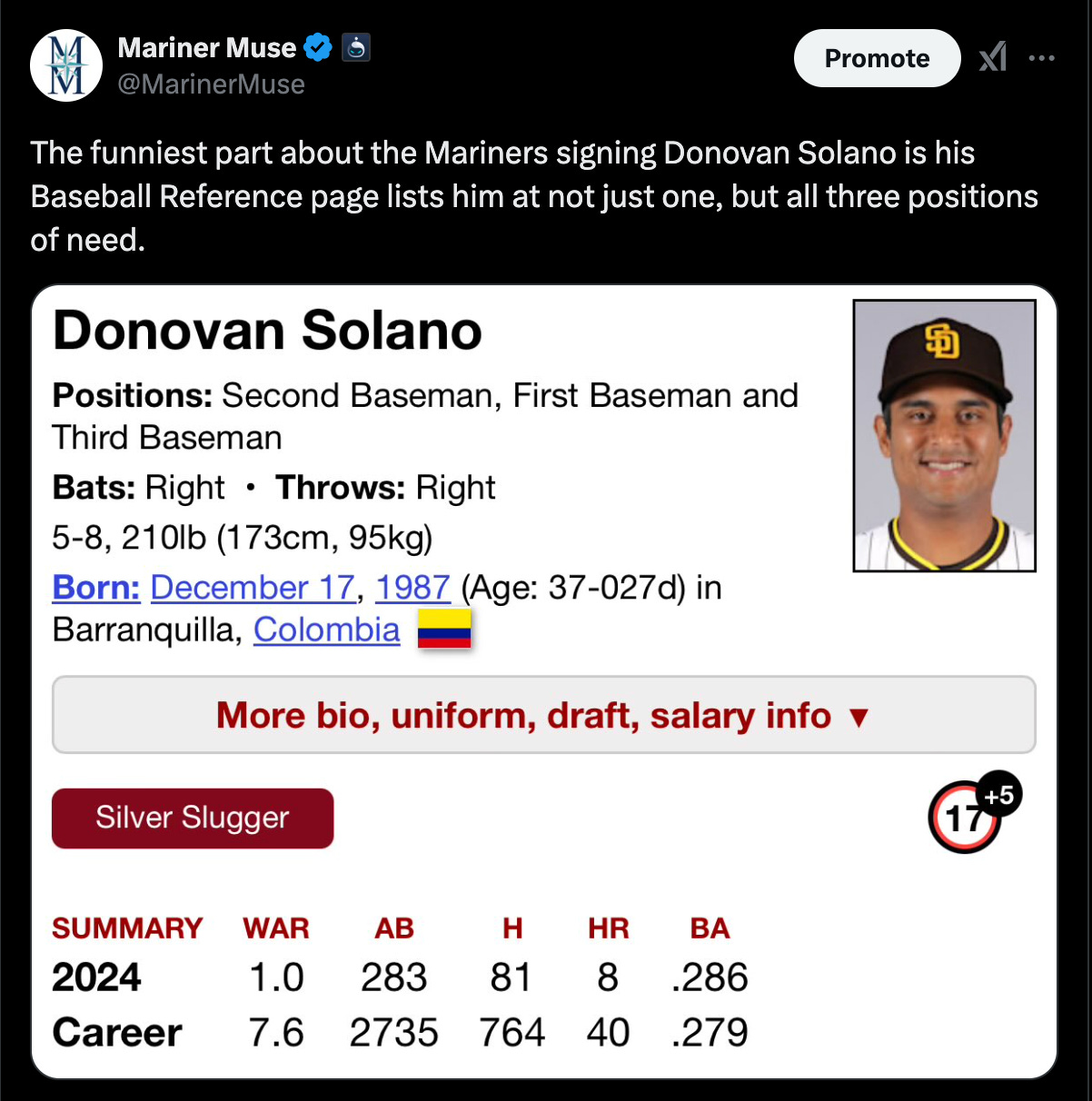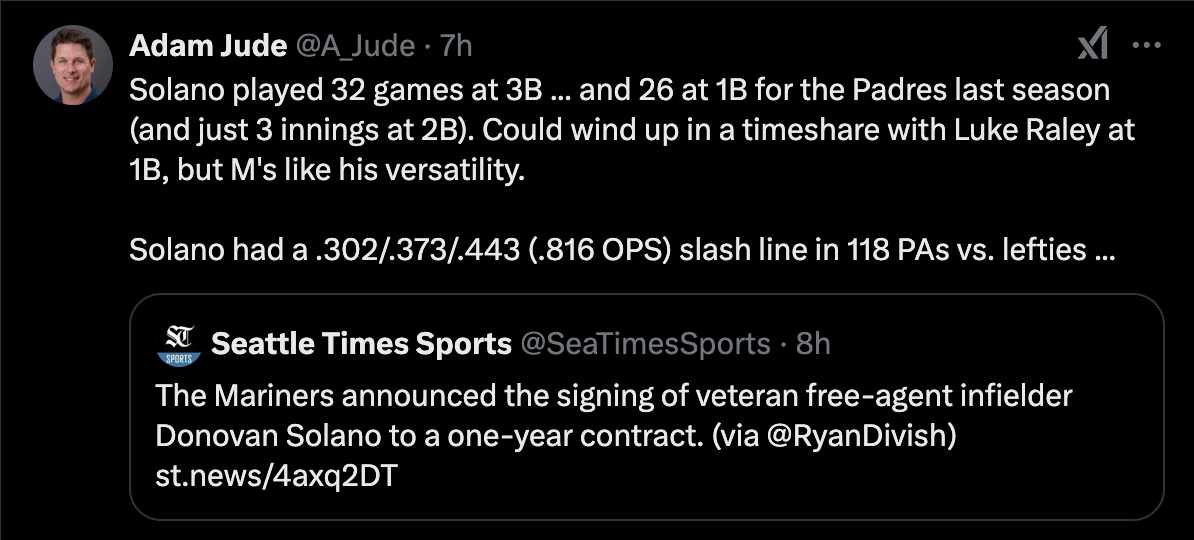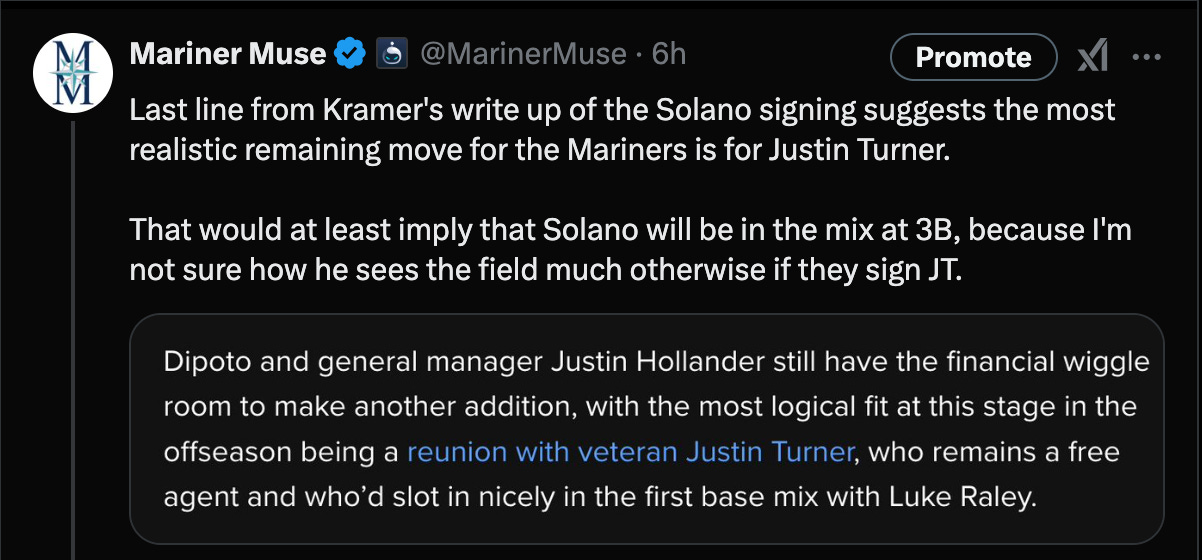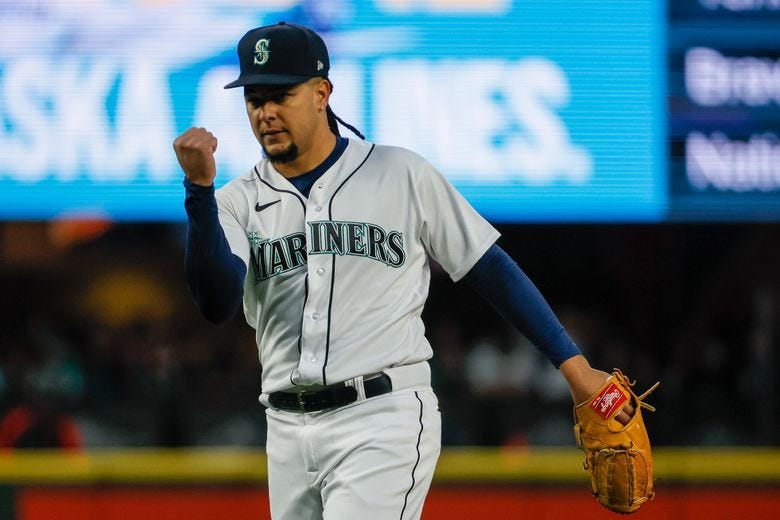The Mariners finally make a move
After a winter freeze, Seattle signed IF Donovan Solano to a one-year deal Monday
At long last, the Mariners struck for the first guaranteed addition to their 26-man roster of the offseason Monday.
Seattle signed infielder Donovan Solano to a one-year, $3.5 million deal, with an additional $1 million in incentives, per Robert Murray. Solano, 37, plays all three spots on the infield, but none particularly well. What he does do is hit for a high batting average consistently despite his age and lack of speed.
From 2019 through 2024, Solano posted a wRC+ between 99 and 125 in every season. After hitting .330 and .326 with the Giants in 2019 and 2020, Solano has hit between .280 and .286 for four different teams, two with extreme hitter’s parks in Cincinnati and Minnesota and two with some of the least friendly hitting environments in the league in San Francisco and San Diego.
Solano’s ability to hit with consistency wherever he plays will be extremely relevant as he joins the Mariners for his age-37 season. He doesn’t add any value as a runner or defender, and his eight homers with the Padres last season was a career high. The Mariners are paying him to be that .280 hitter with a .750 OPS and an elite ability to find the launch angle sweet spot he has regularly been for the past four years.
Signing Solano does come with some risk that he could hit an age cliff and provide zero value. If he hits .260 with a .700 OPS, as Fangraphs currently projects, he will struggle to post even a 1-win season. The Mariners will hope Solano can replicate his recent offensive production, but at just $3.5 million, if he totally flops, they won’t find it nearly as hard to part ways with him as they did recently with veteran additions like A.J. Pollock, Kolten Wong, Jorge Polanco and Mitch Garver.
Where Solano fits into the Mariners’ overall plan for their 2025 roster remains a bit of a mystery. The Mariners have clear weaknesses and available playing time at 3B, 2B, right-handed 1B and DH. Solano’s Baseball Reference page, hilariously, lists him at all three of those infield positions, and he also spent significant time as a DH last year. Solano could potentially help with every major need the Mariners have, but he also can’t be cloned to fill them all, despite advances in modern science.
For some reason, the Mariners have pushed the hardest to upgrade their situation at 1B this offseason, suggesting they aren’t comfortable with a Luke Raley/Tyler Locklear platoon. By most accounts, signing 2022 folk hero Carlos Santana was essentially Plan A for the Mariners front office this offseason. The Mariners pushed hard for Santana, per Ken Rosenthal, offering him a contract that included an option for a second year in 2026, despite that being Santana’s age-40 season. After the Cleveland Guardians traded Josh Naylor to the Arizona Diamondbacks, the team that Santana spent parts of 10 seasons with came calling with a one-year, $12 million deal.
For the Padres in 2024, Solano started in the field in 46 games, playing most commonly at 3B, slightly less often at 1B, and making a brief cameo at 2B. He’s played the most career games at 2B by far. It’s not entirely clear where the Mariners see him playing the most, but some early indications have pointed toward a platoon partnership with Luke Raley at 1B and some consistent reps at DH.
Solano profiles as an excellent short-side platoon bat, as he posted a sterling 134 wRC+ against left-handed pitchers last season. He’s been consistently well above league average against lefties since 2019. He also isn’t too shabby against RHP either, meaning he can likely handle playing everyday for extended stretches if necessary.
The dilemma with signing Solano to this roster is whether they can get significant plate appearances at either 3B or 2B out of him without horrible defense or affecting his steadiness at the plate. Dylan Moore projects to see nearly 600 plate appearances under the existing structure of the Mariners roster. He set his career high in plate appearances in 2024 with 441, and shouldn’t be asked to push past that mark by nearly 150. Other players projected for significant playing time at 2B and 3B right now include Ryan Bliss (280), Cole Young (266), Leo Rivas (126) and Nick Dunn (105). The addition of Solano could lower some those numbers significantly or have very little impact on them at all, depending on the Mariners’ vision and additional moves.
So what happens now?
The Mariners entered the offseason wanting to add two or three infielders, but after they struck out on Santana and Korean IF Hye-Seong Kim, three seems like a bit of a pipe dream.
Three seems more realistic if you count INF Austin Shenton as part of that group. Shenton, acquired from the Rays in November after he was designated for assignment, was the only player projected to be on the 26-man roster who joined the organization since the 2024 season ended before Solano signed Monday. A native of Bellingham, he’s a 27-year-old corner infielder and left-handed bat who spent three seasons with the Mariners before he was traded at the 2021 Trade Deadline for the Dominican Big Boss, Diego Castillo.
Shenton has more professional experience at 3B than any other position, but he played more 1B in 2024, as Rays top prospect Junior Caminero played mostly 3B for the AAA Durham Bulls. Shenton only appeared at 1B and DH in his brief MLB stint, and given less than glowing reports about his defensive acumen, it’s dubious to expect him to contribute in a big way at 3B. Still, Shenton is preferable to Dominic Canzone as a left-handed bench bat, so he may make the Mariners roster out of Spring Training.
Before the Solano signing, Shenton was penciled in for just 217 plate appearances despite making the projected Opening Day bench even after Solano’s addition, per Roster Resource. The Mariners need to add one more bat to push Canzone off the roster, so it seems likely they will shoot for another addition, and potentially treat Shenton as the third infielder, depending on if they can pull off two better additions.
While Solano’s potential to be merely a 1B/DH makes the roster fit awkward, MLB.com’s Daniel Kramer suggested in his write up of the signing that the Mariners are still interested in bringing back 1B/DH Justin Turner. Turner, the other veteran option in the Santana mold, appears to be waiting out the market, and he made $13M last season and likely won’t be keen to leave home for much less.
Turner posted a 126 wRC+ in 48 games after the Mariners got him from the Toronto Blue Jays at the trade deadline. The Mariners relished the impact he had on their clubhouse and indicated early this offseason that they were interested in a reunion.
While the additions of Solano, Shenton and Turner are all decent moves in isolation, taken together, they form an extremely underwhelming offseason. A couple of 1-WAR infielders who could fall off the age cliff at any moment and an overage, fringy prospect with 50 career MLB plate appearances is anything but splashy, and lacks ambition for driving the Mariners forward in their status as contenders.
Can the offseason still be saved?
The problem remains what’s plagued the Mariners all offseason so far: there’s not much they can realistically do. They can’t afford Alex Bregman for 3B, Pete Alonso for 1B or Anthony Santander for DH with the roughly $15 million they reportedly still have available to spend. The rest of the free agent market at 2B and 3B is largely terrible, with the most realistic everyday 3B available probably Yoán Moncada, who would have to take a cheap deal to attempt a bounce back in a terrible hitter’s park like T-Mobile. The most realistic starting 2B on the market could be Mariners reunions with Jorge Polanco or Adam Frazier.
On the trade market, the Mariners asked the Phillies about 3B Alec Bohm, an obvious change-of-scenery candidate, but the Phillies reportedly wanted Logan Gilbert or George Kirby. The Mariners also expressed interest in Cubs 2B Nico Hoerner, but the Cubs reportedly want to acquire MLB players in return, and the Mariners don’t have valuable MLB players to spare on their roster. Red Sox 1B Triston Casas has been linked to the Mariners this offseason, but Boston apparently asked for Bryce Miller or Bryan Woo, another non-starter for Seattle.
With resources limited, the Mariners also explored trading Luis Castillo, who is set to make $22.5M per year over the next three seasons. While considering this move, the Mariners seem to want to add MLB impact at multiple offensive positions while also saving significant money. That, frankly, doesn’t seem feasible, and the Mariners have reportedly been frustrated by the discussions they’ve had about Castillo. Even if they were to find the perfect version of this extremely specific framework, Castillo has a full no-trade clause and would need to approve any deal through the end of 2025.
The largest hurdle they’re facing is a paucity of teams wanting to deal MLB players for prospects. Too many teams are attempting the strategy at the core of the Mariners’ baseball operations, trying to be good enough to push for the playoffs and see what happens after that. MLB’s race to the middle sees fewer and fewer teams attempting preseason resets. Largely, only the White Sox and Marlins are taking prospects for MLB players at the moment, and those teams don’t have above-average MLB players in abundance to sell.
The Mariners will likely target follow-up moves for any remaining additions outside of Turner or maybe Moncada. If Bregman or Alonso sign with the Mets, they could trade for Brett Baty as a buy-low strong-side platoon bat with upside at 3B. If Bregman lands in Detroit, they could look at Matt Vierling for 3B or promising youngster Jace Jung, the Tigers’ 2022 first-round pick who plays both 2B and 3B.
Still, the Mariners’ elimination from the Roki Sasaki sweepstakes likely erased the possibility of an offseason befitting a team that could push for a pennant in a soft American League. A Solano-Turner-Shenton offseason, even with a Baty-type added in, dooms the Mariners to another winter of half measures, brought on by years of ownership cheapness and baseball executive risk aversion.
An offseason like this could keep Seattle above water, pushing for another playoff appearance, and who knows what could happen after that. But three or four more half measures won’t do anything to assuage the concerns from fans that the leaders of this baseball team lack the necessary ambition to win the World Series.





